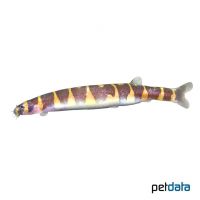Giant Kuhli (Pangio myersi)
| Giant Kuhli Pangio myersi | |
|---|---|
| Name | Giant Kuhli |
| Name Lat. | Pangio myersi |
| Synonym | Acanthophthalmus myersi |
| Family | Longfin Loaches |
| Family lat. | Cobitidae |
| Order | Carps |
| Order lat. | Cypriniformes |
| Origin | Southeast Asia |
| Habitat | Streams, ponds |
| Diet | Carnivore |
| pH | 4.0-7.0 |
| Behavior | Nocturnal, peaceful |
| Keeping | Swarm |
| Care Level | Moderate |
| Reproduction | Egg scatterer |
| Breeding | Difficult |
| Life Span | 5-8 years |
| Protection | No |
| Metric Units | |
| Size | 10 cm |
| Temperature | 21-26 °C |
| Hardness | 1-8 °dH |
| Aquarium | ~ 100 l |
| US Units | |
| Size | 4" |
| Temperature | 70-79 °F |
| Hardness | 18-142 ppm |
| Aquarium | ~ 25 gal |
Distribution and habitat
The range of the giant thorneye is the lower Mekong basin in Laos, Cambodia and Vietnam, and southeastern Thailand. They live in stagnant or slow-moving, shallow waters, such as stillwater of small rivers, tributaries, ponds and swamps with soft, muddy bottoms, among fallen leaves, plants and roots.
Maintenance
The aquarium should have dense planting with numerous hiding places (roots, stones, caves). To be able to burrow in, they need a soft, fine-grained substrate (sand, round gravel) covered with some mulm and foliage (e.g. sea almond tree, oak). Subdued light (floating plants) and soft, slightly acidic water with little current is ideal.
No ammonia, ammonium and nitrite should be detectable, the nitrate value should not exceed 100 mg/l. To ensure the water quality and oxygen content, a filter and heater adapted to the aquarium size is required, as well as lighting for the species-appropriate day-night rhythm of the animals.
Diet
They feed mainly on bottom-dwelling small crustaceans (bosmids, ostracods, etc.). The food supply consists of live, frozen and dry food. For a balanced diet, feed once a day with a high quality sinking dry food (granules, pellets, tablets) as well as cyclops, daphnia, artemia, bosmids, tubifex and mosquito larvae (live or frozen)
It is recommended to feed small portions several times a day. Only feed as much as will be eaten within a few minutes. A regular and varied diet promotes health and prevents deficiency symptoms.
Behaviour and compatibility
These gregarious, crepuscular to nocturnal fish are completely peaceful. At least 10 Giant Dogfish should be kept together. They are well suited for a community tank with other calm and peaceful fish, such as barbs, rasboras, gourami, etc.
Basically, only compatible fish species with similar water condition and water temperature requirements should be socialized.
Sex dimorphism
There are no definite distinguishing characteristics. Adult females are slightly larger and rounder than males of the same age.
Reproduction and breeding
Breeding in the aquarium has occasionally been successful.
Important
They are predominantly crepuscular to nocturnal and remain mostly hidden in burrows or under rocks and roots during the day
The foliage (e.g. sea almond tree or oak leaves) not only provides cover, but also promotes the development of microorganisms when rotting, which are a valuable secondary food source.
When fishing, use the finest mesh nets possible to avoid snagging the subocular spines (under the eye) that are normally hidden beneath the skin.
The well-being of the fish should be checked regularly. Temperature should be checked daily, pH, hardness and nitrate levels should be checked at least every 14 days. Regular partial water changes are recommended, even if the contaminant level has not yet reached the upper limit. Sudden changes in water quality should be avoided. Newly introduced fish must be accustomed slowly to the water in the aquarium.
Further literature can be found in your pet store.
References
Text: petdata; Image: petdata
Source: BMELV (1998): Tierschutzgutachten - Haltung von Zierfischen (Süßwasser); RIEHL & BAENSCH (2006): Aquarien Atlas Bd. 1, Mergus Verlag; ENGELMANN (2005): Zootierhaltung - Tiere in menschlicher Obhut: Fische, Verlag Harri Deutsch
- Gemäß § 21 Abs. 5 Tierschutzgesetz idgF
